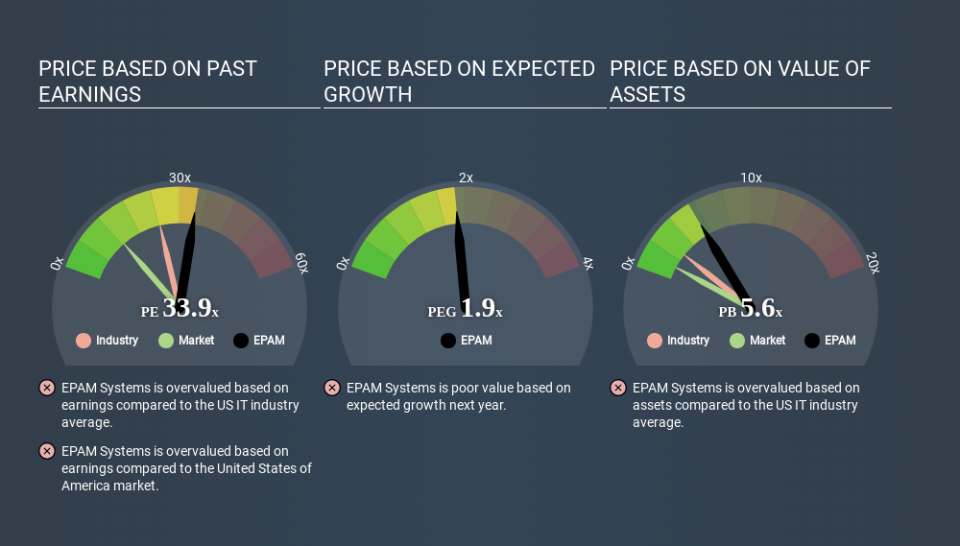What Is EPAM Systems's (NYSE:EPAM) P/E Ratio After Its Share Price Tanked?

To the annoyance of some shareholders, EPAM Systems (NYSE:EPAM) shares are down a considerable 30% in the last month. The recent drop has obliterated the annual return, with the share price now down 4.0% over that longer period.
All else being equal, a share price drop should make a stock more attractive to potential investors. While the market sentiment towards a stock is very changeable, in the long run, the share price will tend to move in the same direction as earnings per share. The implication here is that long term investors have an opportunity when expectations of a company are too low. Perhaps the simplest way to get a read on investors' expectations of a business is to look at its Price to Earnings Ratio (PE Ratio). Investors have optimistic expectations of companies with higher P/E ratios, compared to companies with lower P/E ratios.
See our latest analysis for EPAM Systems
Does EPAM Systems Have A Relatively High Or Low P/E For Its Industry?
We can tell from its P/E ratio of 33.87 that there is some investor optimism about EPAM Systems. You can see in the image below that the average P/E (23.7) for companies in the it industry is lower than EPAM Systems's P/E.
That means that the market expects EPAM Systems will outperform other companies in its industry. Shareholders are clearly optimistic, but the future is always uncertain. So further research is always essential. I often monitor director buying and selling.
How Growth Rates Impact P/E Ratios
Generally speaking the rate of earnings growth has a profound impact on a company's P/E multiple. Earnings growth means that in the future the 'E' will be higher. And in that case, the P/E ratio itself will drop rather quickly. And as that P/E ratio drops, the company will look cheap, unless its share price increases.
EPAM Systems's earnings per share grew by 6.5% in the last twelve months. And it has bolstered its earnings per share by 26% per year over the last five years.
Don't Forget: The P/E Does Not Account For Debt or Bank Deposits
One drawback of using a P/E ratio is that it considers market capitalization, but not the balance sheet. In other words, it does not consider any debt or cash that the company may have on the balance sheet. Theoretically, a business can improve its earnings (and produce a lower P/E in the future) by investing in growth. That means taking on debt (or spending its cash).
Spending on growth might be good or bad a few years later, but the point is that the P/E ratio does not account for the option (or lack thereof).
EPAM Systems's Balance Sheet
With net cash of US$911m, EPAM Systems has a very strong balance sheet, which may be important for its business. Having said that, at 10% of its market capitalization the cash hoard would contribute towards a higher P/E ratio.
The Verdict On EPAM Systems's P/E Ratio
EPAM Systems trades on a P/E ratio of 33.9, which is above its market average of 12.4. Earnings improved over the last year. And the net cash position provides the company with multiple options. The high P/E suggests the market thinks further growth will come. What can be absolutely certain is that the market has become significantly less optimistic about EPAM Systems over the last month, with the P/E ratio falling from 48.7 back then to 33.9 today. For those who don't like to trade against momentum, that could be a warning sign, but a contrarian investor might want to take a closer look.
Investors have an opportunity when market expectations about a stock are wrong. As value investor Benjamin Graham famously said, 'In the short run, the market is a voting machine but in the long run, it is a weighing machine. So this free visual report on analyst forecasts could hold the key to an excellent investment decision.
Of course you might be able to find a better stock than EPAM Systems. So you may wish to see this free collection of other companies that have grown earnings strongly.
If you spot an error that warrants correction, please contact the editor at editorial-team@simplywallst.com. This article by Simply Wall St is general in nature. It does not constitute a recommendation to buy or sell any stock, and does not take account of your objectives, or your financial situation. Simply Wall St has no position in the stocks mentioned.
We aim to bring you long-term focused research analysis driven by fundamental data. Note that our analysis may not factor in the latest price-sensitive company announcements or qualitative material. Thank you for reading.



